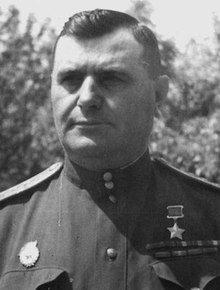Andrey Kravchenko (general)
Andrei Grigoryevich Kravchenko | |
|---|---|
 | |
| Native name | |
| Born | 18 November [O.S. 30 November] 1899 Sulimivtsy, Poltava Governorate, Russian Empire (now Ukraine) |
| Died | 18 October 1963 (aged 63) Moscow, Soviet Union |
| Allegiance | |
| Service | Red Army |
| Years of service | 1918–1955 |
| Rank | Colonel General |
| Battles / wars | Russian Civil War Soviet Finnish War Great Patriotic War |
| Awards | Hero of the Soviet Union (twice) |
Andrey Grigoryevich Kravchenko (Russian: Андре́й Григо́рьевич Кра́вченко; 18 November [O.S. 30 November] 1899 – 18 October 1963) was the commander of multiple tank units of the Red Army throughout World War II who was twice awarded the title Hero of the Soviet Union.[1]
Early life
Kravchenko was born in a farming family in the village of Sulimivtsy near Poltava, Ukraine. He was an ethnic Ukrainian. Kravchenko fought in the Russian Civil War. He was educated at the Poltava infantry Academy (1923) and the Frunze Military Academy. He subsequently served with the infantry and taught at the Saratov Tank Warfare school. From 1939 he was attached to the Volga Military District as chief of staff of the 61st Rifle Division. Kravchenko fought in the Soviet Finnish War as chief of staff of the 173rd Motorized Division. In 1940 Kravchenko was appointed chief of staff of the 16th Tank Division and later the 18th Mechanised Corps.
World War II
Kravchenko commanded the 2nd Tank Corps, 4th Tank Corps, 5th Guards Tank Corps and 6th Guards Tank Army during World War II. He fought in the Battle of Moscow, the Battle of Stalingrad,[2] the Battle of Kursk at the Battle of Prokhorovka, the Battle of the Dnieper, the Korsun-Shevchenkovsky Offensive,[3] the Uman–Botoșani Offensive, the Second Jassy–Kishinev Offensive, the Vienna Offensive and the Bratislava–Brno Offensive. After the German surrender, Kravchenko's 6th Guards Tank Army was transferred to the Far East and fought in the Soviet invasion of Manchuria as part of the Transbaikal Front.[4][5]
Postwar
Kravchenko graduated from the higher academic courses at the Military Academy of the General Staff in 1949. He subsequently commanded tank forces and was commander of the Far Eastern Military District from 1954. Kravchenko retired from the army in 1955 and served as a deputy in the Supreme Soviet. He died on October 18, 1963. He was buried in Moscow at the Novodevichy cemetery. A bronze bust to Kravchenko was installed at his former home in Sumy.
References
- ^ Указ Президиума Верховного Совета СССР «О присвоении звания Героя Советского Союза генералам, офицерскому, сержантскому и рядовому составу Красной Армии» от 10 января 1944 года // Ведомости Верховного Совета Союза Советских Социалистических Республик : газета. — 1944. — 19 января (№ 3 (263)). — С. 1
- ^ Zhukov, Georgi K.; Salisbury, Harrison Evans; Glantz, David M. (2002-01-01). Marshal Zhukov's Greatest Battles. Rowman & Littlefield. ISBN 9780815410980.
- ^ Glantz, David M. (2014-02-04). From the Don to the Dnepr: Soviet Offensive Operations, December 1942 - August 1943. Routledge. ISBN 9781135181307.
- ^ "Andrey Kravchenko". Герои страны ("Heroes of the Country") (in Russian).
- ^ Glantz, David (2004-08-02). The Soviet Strategic Offensive in Manchuria, 1945: 'August Storm'. Routledge. ISBN 1135774986.
- 1899 births
- 1963 deaths
- Heroes of the Soviet Union
- Recipients of the Order of Lenin
- Recipients of the Order of the Red Banner
- Recipients of the Order of Suvorov, 1st class
- Recipients of the Order of Bogdan Khmelnitsky (Soviet Union), 1st class
- Recipients of the Order of Suvorov, 2nd class
- Recipients of the Order of Kutuzov, 2nd class
- Soviet colonel generals
- People from Poltava Governorate
- Frunze Military Academy alumni
- Military Academy of the General Staff of the Armed Forces of the Soviet Union alumni
- Soviet military personnel of World War II from Ukraine
